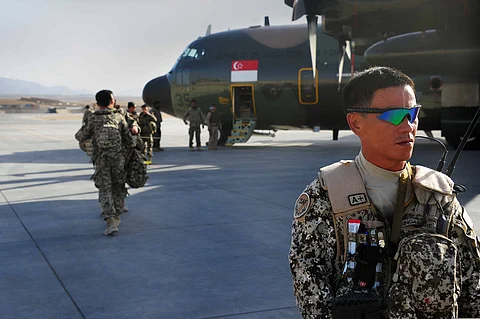
- Insights
- Cryptocurrencies
- Stocks
- White Papers
- Industry
- Geography
- Insights
- Cryptocurrencies
- Stocks
- White Papers
- Industry
- Geography


Singapore's Minister of Defence Dr. Ng Eng Hen and Second Minister for Defence Mr. Ong Ye Kung recently spoke in the Parliament about harnessing technology to overcome constraints faced by the Singapore Armed Forces (SAF). The Republic of Singapore Air Force (RSAF) and the Republic of Singapore Navy (RSN) are actively tapping into the power of artificial intelligence, analytics and robotics to decrease the need of manpower while improving efficiency.
The concept of a 'Smart Airbase' is being explored by the RSAF in collaboration with the Defence Science and Technology Agency (DSTA) for generating and sustaining power for the Singapore Armed Forces (SAF). The concept covers self-organized drones capable of detecting damage on the airfield. The drones are fitted with an electro-optical camera and a light detection and range sensor (LIDAR). The defects are coded in various colors according to their nature whether it's a carter or a pothole and the location and diameter. The data collected is then transferred to the ground station for further action. The operating tests for the drones began in January at the Tengah Airbase.
Aircraft damage inspection, runway assessments and repairs and runway security will all have more automation and unmanned systems working. But most importantly, reducing the margin of error in generating the right number of aircrafts in the right configuration and ensuring their takeoffs at the right time for missions, is what is being targeted by the 'Smart Air Base' concept.
An excerpt from a fact sheet from the Ministry of Defence Singapore (MINDEF) mentions "In the envisaged Smart Airbases the Base Command Post will be better networked to all airbase systems, and decision support systems (DSS) enabled by data analytics, and artificial intelligence will be used to make sense of voluminous amount of data and provide recommendations for follow-on actions." Automating complex airbase operations for faster decision-making is being focused on.
Damage classification and repair work is a labor-intensive task and consumes a lot of time. Using drones can speed up this process. For instance, Tengah Air Base runway can be covered in about five minutes by a drone flying at a speed of say 10 meters per second. The automated decision systems will then organize the repair work based on the priority and suggest other routes to minimize any form of disruption in the aircraft activity. Technology at the Smart Airbase can also be used to catch hold of errant drones using radiofrequency jammer. This jammer, due to signal interference, will cause the drone to return to its base after hovering at a spot.
There are other significant features listed in the factsheet from MINDEF. The first one concerns the 'automation of aircraft inspection'. Usually, before the take-off of a flight, a ground crew consisting of around three to four members inspects the flight. An F-16 flight, for example, needs anywhere from one to three hours to get ready and half of that time is meant only for inspection. Bringing in an automated system will reduce the aircraft turnaround time. The aircraft hangars will be equipped with unmanned ground vehicles and sensors to identify abnormalities and plot them onto a 3-D model.
The second feature is that of the 'Smart Fleet Management' system. Data analytics will be applied to aircraft information to gain insights about the performance parameters and help in proactive maintenance. Lastly, 'Enhanced Air Base Security' will be stressed upon with the implementation of facial recognition and biometric verification. Intrusions and suspicious activities will also be taken care of using advanced sensors and video analytics.
The head of air base operability systems in the Air Force's air plans department, Military Expert 5 (ME5) Tommy Ong said: "We are still in the midst of a trial and experimenting with these technologies. We can only quantify the savings at a much later date when we have more insights into the readiness and maturity of these technologies."
